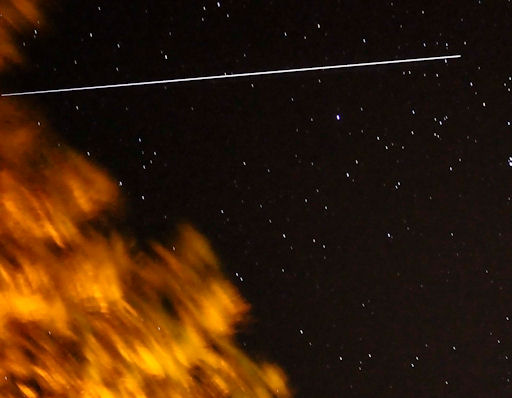PARTIAL ECLIPSE OF THE STRAWBERRY MOON: On Monday, June 4th, the Moon will pass through the shadow of Earth, producing a partial lunar eclipse visible across the Pacific from China to the United States. Get the full story from Science@NASA.
DRAGON CAPTURED! The International Space Station Expedition 31 crew successfully captured the SpaceX Dragon capsule with the station's robotic arm at 9:56 AM EDT. The feat came 3 days, 6 hours, 11 minutes and 23 seconds after the mission's launch. The station was 251 miles over northwest Australia when capture occurred. Next step: docking. [updates]
Geoff Horner saw the two spacecraft converging last night over St. George, Utah. Click to view a close-up image of the pair:
"This was my best opportunity to capture this historic event from my location," says Horner. "The ISS and Dragon were shining at magnitudes -2.4 and 1.9, respectively. The two spacecraft were leaving Earth's shadow, separated by a matter of seconds, as they cruised by the end of the Big Dipper's handle!"
After docking, the Dragon will remain connected for about three weeks, giving astronauts plenty of time to unload its 1200 lb of supplies and re-load it with used scientific equipment for return to Earth. Reversing the process of connecting the spacecraft to the station, astronauts will use the robotic arm to remove the capsule. The Dragon will then de-orbit and return to Earth under parachutes, splashing down in the Pacific Ocean off the California coast.

![]()
Solar wind
speed: 454.4 km/sec
density: 1.3 protons/cm3
explanation | more data
Updated: Today at 1716 UT
![]()
X-ray Solar Flares
6-hr max: C1 1555 UT May25
24-hr: C1 1014 UT May25
explanation | more data
Updated: Today at: 1700 UT
![]()
![]()
![]()
Daily Sun: 25 May 12
![]()
![]()
Crackling with C-class solar flares, a new sunspot is emerging at the circled location. Credit: SDO/HMI
![]()
![]()
![]()
Sunspot number: 96
What is the sunspot number?
Updated 24 May 2012
Spotless Days
Current Stretch: 0 days
2012 total: 0 days (0%)
2011 total: 2 days (<1%)
2010 total: 51 days (14%)
2009 total: 260 days (71%)
Since 2004: 821 days
Typical Solar Min: 486 days
Updated 24 May 2012
The Radio Sun
10.7 cm flux: 116 sfu
explanation | more data
Updated 24 May 2012
![]()
![]()
![]()
Current Auroral Oval:
![]()
Switch to: Europe, USA, New Zealand, Antarctica
Credit: NOAA/POES
![]()
![]()
![]()
Planetary K-index
Now: Kp= 2 quiet
24-hr max: Kp= 2 quiet
explanation | more data
![]()
Interplanetary Mag. Field
Btotal: 2.8 nT
Bz: 1.7 nT south
explanation | more data
Updated: Today at 1716 UT
![]()
![]()
![]()
Coronal Holes: 25 May 12
![]()
![]()
There are no large coronal holes on the Earthside of the sun. Credit: SDO/AIA.





